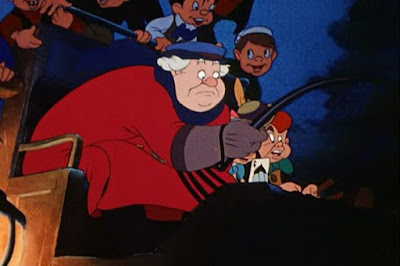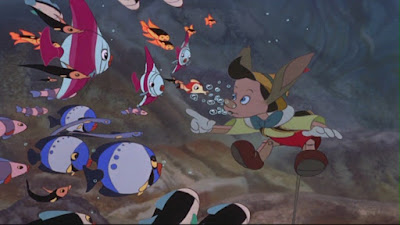Work on Disney's second animated feature began while Snow
White and the Seven Dwarfs was being completed in 1937. But as soon as 1938,
there was talk that Bambi would be the second animated film released as
there were story difficulties with Pinocchio. Disney discarded 2300 feet
of the film, or what is believed to have been 5 months of work. This was
apparently footage supervised by David Hand, who would not receive onscreen
credit when the film was released.
Pinocchio’s look was probably part of the problem, as
according to Bob Jones, the supervisor of the department at Disney to design
and manufacture character models, “at least 12 Disney artists struggled over an
18-month period--each contributing their own ideas--before the design [for
Pinocchio] was finalized."
Jiminy Cricket was a bit of an afterthought. There is a
cricket in Collodi’s original story, but rather than being the puppet boy's conscience, the puppet kills the cricket. Naming him Jiminy, Disney asked his
artists to create a cricket who looked "like a human being" and
"talked and wore clothes."
All-in-all, a contemporary study guide for the picture
stated that 2,000,000 drawings were created, of which 300,000 were used in the
final film. The budget was $2.5 million, much of which went into the scenes
filmed by the multiplane camera, single sequences of which cost up to $48,000.
The film had its premiere in New York on February 7, 1940, and was in general release on February 23, 1940. While the film is now
considered a classic, when it was first released, the film was considered a
box-office bomb. Such were the times, when World War II cut off Europe and Asian
markets. The film didn’t turn a profit until its 1945 re-release.
 |
| Jiminy Cricket sees a fire in Geppetto's shop and doesn't see why it should go to waste. |
Loosely narrated by Jiminy Cricket (Cliff Edwards), the film opens in the shop of Geppetto (Christain Rub), a lonely woodcarver in an unidentified European village. Jiminy has snuck into the shop to warm himself by the fire and observes Geppetto putting the final touches on a marionette he calls Pinocchio. While Geppetto enjoys playing with the doll, he confesses to his pets Figaro the kitten and Cleo the goldfish that he wishes Pinocchio was a real boy.
 |
| Geppetto putting the final touches to Pinocchio. |
While he sleeps, his wish is granted by The Blue Fairy (Evelyn Venable), who gives life to Pinocchio (Dickie Jones). But he is not a “real boy” yet; he has to earn that. According to the Fairy, he has to exhibit the virtues of truth, courage, and selflessness. She tasks Jiminy with serving as the boy’s conscience, dubbing him the "Lord High Keeper of the Knowledge of Right and Wrong." She promises Jiminy a gold badge if he makes good.
 |
| The Blue Fairy makes Pinocchio real. |
When Geppetto hears all the noise in his shop, he arms himself with a pistol and goes to investigate. He is delighted to discover Pinocchio is alive. But the joy is short-lived as the next day, Geppetto sends the wooden boy to school. You might criticize his parenting skills, as he sends the new boy off by himself to not only find the school but to enroll himself. He leaves without his conscience in tow, as Jiminy oversleeps.
.jpg) |
| Honest John (bottom) and Gideon (top) see financial gain when they see Pinocchio. |
On his way, Pinocchio passes J. Worthington Foulfellow, a wily fox also known as "Honest John" (Walter Catlett), and his daffy companion Gideon. That pair has just passed a poster advertising Stromboli’s Marionette Show and they recall scamming him once. When they see Pinocchio, who is basically a stringless marionette, they get the idea to sell Pinocchio to him.
But first, they have to sell Pinocchio on the idea of going
into show business. The promise of fame is too much to resist, so Pinocchio
willingly goes with them, even though Jiminy tries unsuccessfully to talk some
sense into the boy.
 |
| Stromboli is a ruthless showman. |
Pinocchio may be new to show biz, but he’s a big hit for the ruthless showman Stromboli (Charles Judels). After making a lot of money with his new discovery, Stromboli’s not about to let him go home, so he locks him in a birdcage and leaves town.
 |
| Pinocchio's nose grows the more he lies to the Blue Fairy. |
Jiminy figures his job is done, but he decides to say goodbye to his protégé and realizes that he's trapped. Despite his best efforts, he is unable to free Pinocchio. When all hope seems lost, the Blue Fairy comes to their aid. When she asks Pinocchio what happened to going to school, he lies and continues to do so at every question she asks. His nose grows longer and longer until there is a birds nest in the branch he’s growing. She uses this as a lesson, warning him that each lie leads to another and only makes things worse. Hoping he’s learned his lesson, she frees Pinocchio.
 |
| The Blue Fairy is about to free Pinocchio from the cage he's in. |
Meanwhile, Honest John and Gideon are spending their profits on ale and relaying their story to a mysterious Coachman (Charles Judels) who promises greater riches if they come in with him. Even though they find the plan horrible, money talks and they agree to work with him.
Even though he’s hurrying home, Honest John and Gideon
intercept him. Honest John cons Pinocchio into wanting to go to Pleasure
Island, a magical place where boys can do anything they want. He even offers
his ticket, an Ace of Spades he has up his sleeve, so that Pinocchio can get
the rest he needs.
 |
| The mysterious Coachman taking the boys to Pleasure Island. |
Pinocchio joins the other boys on the stage and the ship over to Pleasure Island. The island promises boys the chance to be destructive, to smoke cigars, to drink, and to play pool. Everything that little boys need to turn them into jackasses, which they literally become. Once the boys turn to jackasses, they are caged and sold to work in salt mines and circuses as beasts of burden.
 |
| Pleasure Island. |
Pinocchio ends up tagging along with one of the boys, Lampwick (Frankie Darro), who acts like he knows what’s going on. Pinocchio goes along until they are the last two boys who haven’t turned.
 |
| Once the boys transform, they are rounded up and sold off. |
Jiminy, who has seen what happens to the boys, tries to warn
Pinocchio but arrives too late. Not only has Lampwick changed, but Pinocchio
has already grown ears and a tail. Jiminy leads Pinocchio and the two manage to
escape before Pinocchio’s transformation is complete.
 |
| Lampwick gets transformed. |
This time they finally make it home and they find Geppetto’s store is empty. A letter arrives from the Blue Fairy, in the form of a dove, which tells Pinocchio that Geppetto had gone looking for him on Pleasure Island but had been swallowed by Monstro, a giant sperm whale, and is trapped at the bottom of the ocean.
 |
| Pinocchio goes to the bottom of the ocean to save Geppetto. |
Deciding he has to rescue his father, Pinocchio and Jiminy jump into the Ocean and are swallowed by Monstro and reunited with Geppetto, Figaro, and Cleo. Pinocchio devises a plan to free them. Setting Geppetto’s boat on fire creates so much smoke that Monstro eventually has to sneeze. They all escape on a raft and make it back to shore. However, it appears that Pinocchio has drowned in the process.
 |
| Pinocchio gets turned into a real boy by the Blue Fairy. |
Sadly, they take his body back to Geppetto’s shop and are mourning his loss when the Blue Fairy appears again. Since he has demonstrated the virtues of truth, courage, and selflessness, she turns him into a real boy. She also gives Jiminy a gold badge for his services as Pinocchio's conscience, and as Geppetto and his son celebrate, Jiminy sings that "when you wish upon a star, your dreams come true."
Pinocchio has the distinction of being the first animated
film to win an Academy Award, winning two, not for animation but for Best Song, “When You Wish Upon a Star”, music by Leigh Harline and lyrics by Ned Washington, and Best Score for Leigh Harline, Paul Smith and Ned Washington.
The initial reviews were also very positive. Frank S. Nugent,
writing in The New York Times, opens his review with the following, “If
Westbrook Pegler could write (as he did write in January 1938) that Walt
Disney's 'Snow White' was the happiest event since the armistice, we
can report confidently this morning that Mr. Disney's "Pinocchio" is
the happiest event since the war.” (Westbrook Pegler was a popular columnist in
the 1930s and 1940s.)
While some might disparage the film because it was not as
contagiously tuneful as Snow White, Nugent disagrees, writing “It still
is the best thing Mr. Disney has done and therefore the best cartoon ever made.”
True or not, Nugent imagines “From Disney down to his least inker, animator or
air-brush wielder, we sense a guild of craftsmen smiling over their drawing
boards and paintpots, delighted with the make-believe world they are creating.”
His praise for Pinocchio over Snow White was
repeated in The Hollywood Reporter’s review. “Since comparisons will be
inevitable, it may as well be said at once that, from a technical standpoint,
conception and production, this picture is infinitely superior to Snow
White." Likewise, Variety’s review also praised the animation as “so
smooth that cartoon figures carry impression of real persons and settings
rather than drawings to onlooker."
The impression of real persons may be due to, as Dickie
Jones would later recount, "the facial expressions and lip movements of
Jones and the other actors were shot on 8-millimeter film as a reference for
the animators." Jones also dressed as the character and acted out various
scenes. This is not to take away from the artistry of the animators but to show
the efforts they went to in making the film as good as it could be.
The animation holds up remarkably well, considering it was
made over 80 years ago. What is particularly impressive is the weight given to
Pinocchio to sell the audience that he was made of wood, even when he is just a
marionette puppet that Geppetto is playing with.
The artists also do a great job at such things as realistic water
animation, along with other liquids and smoke. They also do a good job with underwater and glass distortion.
The Blue Fairy appears to be a different style of animation
altogether, rotoscope. It is a technique in which the animator traces over
motion picture footage. The actress who voiced
her, Evelyn Venable, also served as the model for the character design.
The voice acting, which is always hard for me to judge,
seems perfect for the characters. It is hard to imagine how they could have
been improved upon. Cliff Edwards, in particular, seems to strike the right
balance of worldliness and innocence that Jiminy requires. It is hard to
not hear “When You Wish Upon a Star” and not hear him singing it in your head.
The film, like so many of the Disney classics, is a
treasured memory from childhood but one that can be enjoyed at any age.


No comments:
Post a Comment